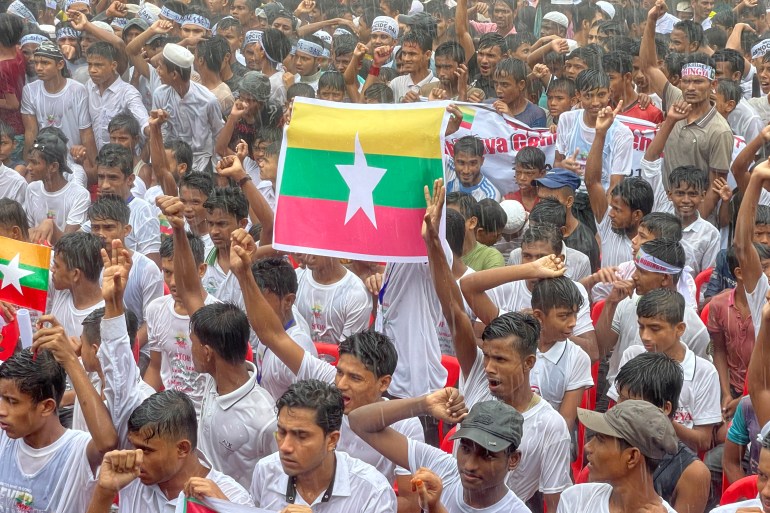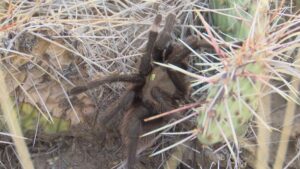Earlier this year, artillery fire crashed through U Khup Thang’s home in Paletwa, in western Myanmar’s Chin State, killing his son. “It felt like a nightmare. I still struggle to find the words to describe it,” said U Khup Thang, an ethnic Chin farmer and labourer. Like others interviewed, he is using a pseudonym for security reasons.
U Khup Thang is one of the hundreds of thousands of people in western Myanmar whose lives have been turned upside down since last November when the Arakha Army (AA) – a powerful ethnic armed group formerly known as the Arakan Army – launched coordinated attacks against military positions.
The attacks opened a new front in a countrywide uprising against the military, which seized power in a 2021 coup. They also marked the beginning of the AA’s second major offensive since 2018, as it seeks to advance its “Arakan Dream” of autonomy over an area which ethnic Rakhine people consider their homeland.
The AA has since made dramatic territorial gains, seizing most of central and northern Rakhine State as well as Paletwa, Chin State. According to a report published in August by the International Crisis Group, the AA now seems to be “on the verge of expelling the military” from the rest of Rakhine State.
The military has retaliated for the AA’s gains by bombing and shelling markets and residential areas. It has largely targeted ethnic Rakhine people for their perceived support to the AA, but other communities have also found themselves caught up in the violence.
In February, the military began a recruitment drive targeting Rakhine State’s persecuted Muslim Rohingya minority, using methods that included abductions, threats and coercion to bring them into its fight against the AA, according to Human Rights Watch (HRW). Crisis Group and others reported that the military had also collaborated with Rohingya armed groups based in neighbouring Bangladesh.
Following these developments, AA forces burned Rohingya villages and killed Rohingya civilians in Rakhine State’s northernmost townships, according to reports by HRW and others. The AA has denied the allegations, instead blaming the military and “Muslim militants” for the violence.
Civilians across all communities, meanwhile, are bearing the burden of the conflict. According to the Center for Arakan Studies, an independent research and rights monitoring organisation, more than 420 civilians have been killed across Rakhine State and Paletwa township since November and nearly 1,000 were injured in conflict-related violence. Some 327,000 people have also been forced from their homes by the fighting, according to the United Nations, which estimated in May that about three million people nationwide had been displaced as a result of conflict, 90 percent of them since the coup.
Al Jazeera spoke with members of six minority groups from Rakhine State and Paletwa. They said the fighting, as well as military blockades on water and road access into the state, had added to the hardships for communities already struggling to survive, while also threatening their lives.
“The conflict disrupted the flow of basic goods including medicine and drove up prices, leaving us feeling helpless,” said U Khup Thang of the months before his house was shelled. Now, living outside the state with support from his church, he wants to return home but is afraid of what might happen. “I have already suffered greatly once,” he said. “I worry that I might not survive this crisis. I cannot afford anything and lack the means to protect myself.”
Cycles of conflict
According to Christopher Win, an activist from Rakhine State’s Maramagyi ethnic minority and a recent graduate of American University’s School of International Service, who has studied the experiences of smaller minorities in Rakhine State, the conflict between the military and AA exacerbates the vulnerabilities of communities who already live with social and economic marginalisation.
“Smaller ethnic minorities in Rakhine and Paletwa … face distinct challenges often overshadowed by the larger conflict,” he said. “These groups suffer from displacement, isolation, and severe shortages of food and medicine. Unlike more visible populations, their struggles are frequently overlooked due to inaccessibility and internet blackouts, leaving them without the crucial support they need.”
Annawar, a Rohingya youth who is going by his nickname, described particular risks for his community because they are less able to flee when disaster strikes. “In this current situation, everyone is seeking a safe place,” he said. “As Rohingya people, we face restrictions on our freedom of movement and are trapped in the conflict zone.”
Excluded from full citizenship rights under a 1982 law, the Rohingya have also faced institutionalised restrictions on their movement since 2012, when mob violence between ethnic Rakhine people, who are predominantly Buddhist, and Rohingya left dozens dead and some 140,000 displaced across the two communities.

Also caught up in the violence were the Maramagyi, a predominantly Buddhist minority who were targeted for their similar language and appearance to the Rohingya. Many fled to Yangon or Mandalay, while thousands took refuge in displacement camps in Rakhine State.
Now, the community is facing a second exodus, according to Naing Naing, a Maramagyi small business owner who is going by a pseudonym. “Only people who were unable to flee due to financial constraints remain in Rakhine State,” he said. “Due to the high prices of goods and basic supplies, they are having a hard time.”
In April, Naing Naing closed his shop in the state capital of Sittwe and moved to Yangon with six members of his family. He is still looking for a new source of income. “We had to start over and build a new life,” he said.
Members of Rakhine State’s Kaman minority are facing a similar crisis. Kamans, who are Muslim like the Rohingya, were also targeted during the 2012 conflict, leaving thousands displaced. Some moved to Yangon or Mandalay, while those who stayed behind saw their rights eroded.
Ruma, a Kaman humanitarian worker who is going by a pseudonym, lives in one of three Kaman villages on the outskirts of Sittwe. She said that since fighting broke out between the military and AA, the sound of armed clashes often kept her awake, and that daily survival was becoming increasingly difficult. It now costs her 70,000 kyats (approximately $15) to drive her motorbike the 10 kilometres (6.2 miles) to her office. She also has to pass through military checkpoints where soldiers hassle her and sometimes demand bribes.
“I feel unsafe, but I can’t avoid meeting them because I need to go to work,” she said.
Meanwhile, her family is cutting back on food and using traditional medicine because they can no longer afford to go to a clinic. “It feels like we are trapped without access to anything,” she said.
Fears of discrimination
In a 2020 speech, AA commander-in-chief Twan Mrat Naing presented a vision for the Arakan Dream which emphasised inclusivity. “All peoples in Arakan, without any discrimination, shall be equally treated,” he said. “We are fighting for freedom, democracy, social justice and welfare, and human dignity for all inhabitants in Arakan irrespective of religion, race or sex.”
Developments in recent months, however, have led some to question the AA’s commitment to these values – particularly in terms of its approach towards the Rohingya. Following the military’s recruitment of the Rohingya people, the AA and its leadership have doubled down on referring to Rohingya as “Bengalis,” a politically-charged term which denies their existence as an Indigenous group in Rakhine State.
In a statement published in March, the United League of Arakan – the AA’s political arm – also warned that any organisation or individual fighting with the military would be attacked, even while acknowledging the military’s forced recruitment of Rohingya people.
Following the recent violence against Rohingya in northern Rakhine State, some activists and human rights organisations have accused the AA of contributing to a genocide against the Rohingya population – claims which the AA has denied. The military faces ongoing charges of genocide at the International Court of Justice for its 2017 campaign of killing, arson and sexual violence against the Rohingya, which drove at least 750,000 people into Bangladesh, where they now live in sprawling refugee camps.

In written comments to Al Jazeera, a ULA/AA spokesperson said that the organisation was committed to building unity and solidarity among diverse ethnic and religious groups in order to promote regional peace and stability, and has already appointed members of these groups in its local administration.
“As an organisation representing all peoples and communities in the region, the ULA has made efforts to ensure the rights and inclusion of minorities,” they said. “Once Arakan’s liberation is achieved … there will be greater opportunities for the inclusion of ethnic and religious minorities within the ULA and other political institutions.”
Members of minority communities described varied interactions with the ULA/AA, which they said was now collecting taxes from civilians in its territory and administering its own justice system.
Ko Htun, a community worker from Rakhine State’s Daingnet community, also known as Chakmas, said that relations are generally positive between his community and the ULA/AA, but that he would like to see the ethnic armed organisation provide more public services. “As far as I know, the AA is taking steps to ensure inclusivity, but most of the time, people have to deal with their livelihoods and difficulties on their own,” he said.
In their comments to Al Jazeera, the ULA/AA spokesperson said the organisation now claims control over 12 townships, where it is providing services including justice, safety and security, healthcare, and emergency humanitarian assistance.
They also said that the ULA/AA collects taxes from civilians using a policy based on principles of equity and neutrality, and that they allow exemptions for those facing economic hardship.
“Building a functional bureaucracy takes time, especially during wartime,” they said. “Despite these challenges, we will continue to do our best to deliver essential public services to the local population.”
Hsan, an ethnic Mro community worker who is going by a pseudonym, shared more grave concerns. He alleged that the ULA/AA has used Mro people and members of other minorities as porters, demanded they contribute rice to its forces, and forcibly conscripted them. He also said that the ULA/AA has, in some cases, required that Mro people seek permission to sell their homes or cut their own trees, and in one instance, stored weapons and ammunition in a village populated by Mro civilians.
“Local people do not feel safe or comfortable interacting with the AA. We must be very cautious about what we say and where we go,” he said. “We feel that we lack freedom, and any mistake in front of them can lead to punishment.”
He added that with the ULA/AA implementing its own justice system in territories under its control, there was little recourse for those claiming abuses by its forces, while few people were speaking out due to pressure, intimidation or the risk of being labelled as a military sympathiser.
“Although the AA claims to operate according to human rights principles, the reality on the ground is quite different,” he told Al Jazeera. “Given the prevailing notion that those who have weapons are more powerful, discussing human rights seems almost impossible.”
Al Jazeera was unable to independently verify his claims, which are similar to those made by several Chin organisations about the AA’s treatment of their community in Paletwa.
‘Exaggerations’
In their comments to Al Jazeera, the ULA/AA spokesperson said the allegations were “misinterpretations and exaggerations of the realities on the ground”.
They denied that the ULA/AA engages in forced conscription, but said that the organisation considers mandatory service from all residents living in its territory as a civic duty during periods of emergency such as wartime. They also denied using civilians as porters or demanding rice from them, and said that they typically base their military camps far from civilian areas.
The ULA/AA, they said, has established mechanisms to resolve disputes and address grievances from civilians, and “respects the rights of all residents to speak out against any injustice.” At the same time, they added, that during wartime, the ULA/AA maintains the right to conduct lawful investigations into potential military spies, for the sake of public safety.
“We follow international human rights law, international humanitarian law, and the Geneva Conventions as part of our military code of conduct,” they said.
Also of concern to minority groups is the ULA/AA’s approach to governance. During an interview published in The Diplomat this month, AA leader Twan Mrat Naing said that after securing an autonomous Arakan, the ULA/AA would roll out a “unitary” system that “prioritises central control”. A more devolved system of governance could wait, he said.
Hsan, the Mro community worker, is concerned that this approach could turn into a form of “dictatorship” replicating the centralised structure of the Myanmar military. At the same time, he concedes that with the ULA/AA positioned to expand its control, those living in its territory would need to find ways to work with it.
“We cannot live separately… We must coexist,” he said. “The AA must demonstrate a broader and more genuine commitment to the needs of smaller minorities.”
Annawar, the Rohingya youth, added that he would like to see the ULA/AA establish institutional mechanisms that protect minorities, including his own. “A strong and transparent constitution is essential for ensuring the rights and inclusion of all communities,” he said.
Members of minorities also called on the ULA/AA to treat them as equal partners in building a future society.
“All of our concerns and hopes will depend on the leadership and administration of the ULA/AA,” said Ko Htun, the Daingnet community worker. “Every minority group in Rakhine must have the opportunity to participate in decision-making and political processes.”









More Stories
Spider lovers scurry to Colorado town in search of mating tarantulas and community
Father accused of harboring teenage son after learning he was wanted for murder of bar employee
Eastbound I-70 back open near Colorado Mills Parkway after semi fire